Floor insulation in a wooden house: work procedure + popular heaters
In buildings made of wood, the problem of indoor microclimate is especially acute. Due to the drying of floor boards and the appearance of cracks along which drafts roam, the rate of heat loss can reach 30%.
Timely insulation of the floor in a wooden house will help to reduce heat costs, all the more so since it is quite possible to carry out thermal insulation without the involvement of specialists. Agree, this approach to solving the issue will save a decent amount and significantly increase the heat efficiency of the house. Doubt your own strength?
We will help you navigate the variety of insulation methods, and provide practical recommendations for choosing a thermal insulation material. In addition, we describe the technology for performing work using the most popular materials: sawdust, expanded clay and foam.
The content of the article:
Methods of thermal insulation work
Insulation work can be done directly in the living room or from the basement. In the first case, it is customary to talk about thermal insulation from above, in the second - about thermal insulation from below. In addition, you can use other methods of floor insulation, which will be discussed in more detail below.
Method No. 1 - installation of insulation from above
In this case, the insulation is laid directly in the room. Such work is quite easy to do, but a number of problems may arise.
The disadvantages of the “surface” installation of insulation:
- the height of the walls decreases;
- insufficiently warmed the lower layers of the structure
- the insulation layer is under increased load, which is why it is necessary to select a material of increased stiffness.
Due to the above difficulties, specialists, answering the question of how to properly and easily insulate floors in cottages and wooden houses, recommend using this technology only in special cases.
It is necessary, for example, if there is a shallow underground under the building or the building is on a monolithic slab.

Work on laying thermal insulation begins with the dismantling of skirting boards and a finishing floor, which is necessary to gain access to the logs. After that, the support bars are inspected.
Found rotten areas should be removed, replacing them with suitable sized fragments of new beams, which are fixed using galvanized metal corners or channels.
On the lower edge of each log, a cranial beam is strengthened. Boards or wooden panels with a thickness of about 30 mm are laid on the prepared structure without fasteners. The created design must be treated with an antiseptic.
The length of each fragment should be less than the step of installing lags by 10-20 mm.
On the assembled draft floor, waterproofing, insulation, a vapor insulator, a counter-rail, creating a ventilation gap, and, in conclusion, a fine floor covering, are laid.
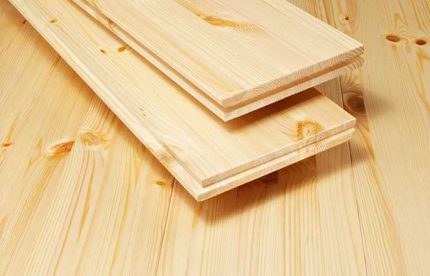
Method number 2 - insulation from the basement
With the option of floor insulation in a private wooden house from below, the installation of a protective coating is carried out between the frame elements and the upper finishing layer.
Carrying out work in this case requires more labor than laying the insulation on top, but the result provides several advantages.
Among the main advantages include:
- the height of the room remains unchanged;
- the insulation layer is not affected by the load from heavy furniture standing on the floor, which allows you to use any kind of materials regardless of their stiffness;
- the heat insulator laid down from the bottom provides protection against freezing not only of the upper layer, but also of the entire floor frame - this reduces the risk of moisture penetration, which increases the life of the structure.
This option is well suited for frame buildings installed on pile and pile-screw foundations.
A prerequisite for the application of such technology is the presence of a cellar, basement or other auxiliary premises under the house.
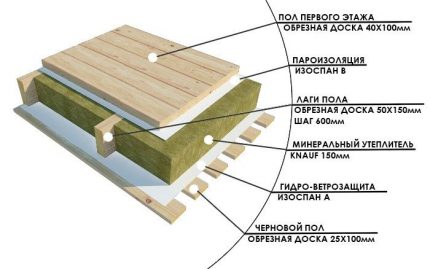
The following procedure is recommended:
- First of all, it is necessary to dismantle the rough old floor in order to gain access to the lags.
- Beams should be cleaned of debris and inspect their condition, replacing damaged fragments, as described above.
- A vapor barrier, such as a membrane, must be installed around the perimeter of the ceiling. If materials are used in rolls, the width of the stripe approach should be greater than 10 cm.
- To the side walls of each log you need to nail a cranial beam 30 * 30 mm. It will serve as a support for the heat-insulating material and create a ventilation gap between it and the final floor.
- After that, the insulation is installed, the thickness of which should not be more than the height of the lag. Depending on the type of insulation, it is strengthened with mounting glue, foam or a transverse rail.
- A waterproofing layer is applied over the layer of the heat insulator, in which quality roofing material or ordinary plastic film is suitable.
The final stage is the application of the topcoat: boards, waterproof plywood or other materials.
Method No. 3 - double sex device
To reduce heat loss in wooden structures, double floors are often applied. In this case, the first step is to install the lag. Uncut boards are fixed on them, which form the so-called draft floor.

Next, they install lags made of thinner timber. The space between them is filled with insulating material. Then impose a finishing floor made of dowel or edged board.
If desired, use also a finishing decorative coating. Between two wooden layers it is convenient to place service communications: corrugated pipes with cables, water supply network.
Instead of laying the rough floor, you can use various types of smooth or embossed floor coverings with a high degree of thermal insulation. These materials are even preferable, as they do not accumulate garbage.
Such a layer is fixed with bustilate glue, which is applied to the material in the form of strips with the obligatory gluing of all joints.
Read more about the technology of floor insulation on logs in this article.
Method No. 4 - underfloor heating system
The "warm floor" technology, which also uses traditional insulation, is very popular, which is quite natural. It provides uniform heating of the entire coating, due to which a comfortable room temperature is effectively realized and its humidity is reduced.
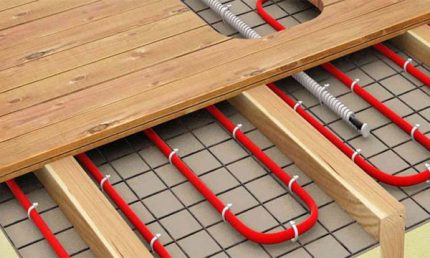
There are two possible variants of such systems, in which heating is carried out using water or electric current.
Water floor construct, adhering to the following sequence of actions:
- Prepare the base, for which concrete slabs are installed or cement screed is performed.
- The surface is covered with the selected insulation, the thickness of which can vary from 2 to 10 cm.
- A reinforcing mesh is laid on top, along which a system of pipelines is fixed, fixed with plastic clamps.
- Next, the surface is filled with special material, and, if necessary, a substrate is arranged.
- The final stage of work water floor arrangements can be considered installation of the finish coating.
Electric "warm floor" It is carried out similarly to the variant described above, however, as a heating element, a cable stretched on a metal mesh is used here, which is firmly connected to the lags.
The laying technology and wiring diagrams of the electric heating system are described in detail here.
An alternative source of heating is infrared film materialswhich are laid directly on the heat-insulating layer covering the screed.
The importance of hydro and thermal insulation
It should be emphasized that for proper insulation of floors in wooden houses, one must not forget about laying hydro / thermal insulation layers.
The waterproofing coating is designed to protect the structure from moisture, which falls on a warm surface when cold air flows. Particles of water penetrating into wooden elements lead to the development of fungi, mold, and, ultimately, to the destruction of the structure.
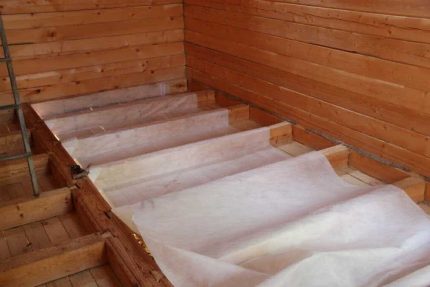
No less important is the vapor barrier layer. The electrical equipment operating in the house, as well as the people in the rooms, constantly generate heat. The warmed air currents from the rooms, which pass through the ceiling of structures, come into contact with cold air masses.
This leads to condensation, the consequence of which may be a swelling of the tree and its decay.
Requirements for Thermal Insulation Materials
There are many types of insulationStarting from simple natural materials and ending with complex synthetic compounds.
In order to make the right choice, you need to consider a number of factors, namely:
- Degree of thermal conductivity. The higher this indicator, the lower the heat loss.
- Term of use. It depends on how long a period of time will require repair work with the replacement of material.
- Insulation weight. Too heavy options are not recommended for use in frame houses.
- Moisture resistance. This factor is especially important if the building is located in a lowland or marshy area, as well as when building houses in a humid climate.
- The presence of unheated premises under the floor. With a cold basement, it is better to give preference to a denser thermal insulation.
- Difficulty level at work. Ease of installation can be considered an indisputable advantage.
- Resistance to fire. The insulation must not burn or sustain combustion, nor should it emit hazardous gases when heated.
It is also necessary to take into account the ability of the material to resist mold, fungi and other destructive biofactors.
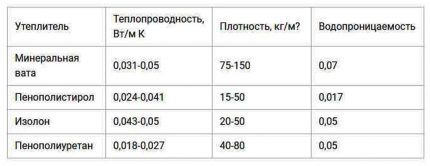
Finally, an important criterion is the cost of the insulating material. Do not chase cheapness: expensive products are usually easy to install and have a long service life, which saves on labor costs and repairs.
Popular materials for insulation
Among the most commonly used heaters are:
- sawdust;
- expanded clay;
- mineral wool;
- Styrofoam;
- penoplex.
Sawdust still popular enough for thermal insulation work. This is an environmentally friendly, affordable and inexpensive product, in addition, it is convenient to use in hard to reach places.
However, it also has drawbacks: over time, the sawdust coalesces, which leads to a loss of quality, they are also exposed to microorganisms, fungi, insects.
Expanded clay - bulk material formed during the firing of clay or slate. This fully eco-friendly ball-shaped material has high thermal insulation performance.
It is resistant to freezing, has good fire resistance. The minuses of expanded clay can be attributed to a relatively large weight, in addition, this material is caked, which leads to shrinkage of the house and a drop in the thermal conductivity.
Mineral wool It is considered one of the best heaters, because it does not burn and does not collapse under the influence of biofactors. In addition to a good indicator of thermal insulation, it also has soundproofing properties.
Among the negative qualities can be noted a small mechanical strength and deterioration of insulating qualities when exposed to water or steam, which requires special attention to steam / waterproofing.
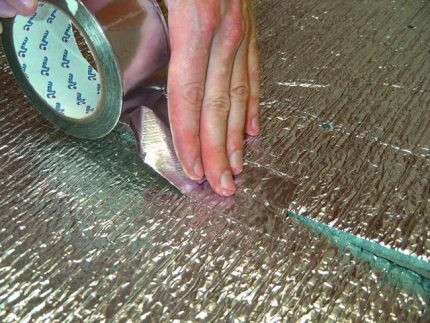
Styrofoam received wide distribution. It easily retains heat, effectively retains heat loss, has sufficient mechanical strength, and a long service life.
It is necessary to remember, however, the negative qualities of this material: during burning, the foam emits toxic substances, in addition, it is able to absorb water, which leads to a decrease in performance.
Penoplex. A relatively recent material that quickly gained popularity. This type of insulation consists of foamed polystyrene plates with excellent thermal insulation characteristics. Plates easy to install do not burn and are not susceptible to bioorganisms.
Other synthetic and natural materials are also used as insulation, among which are isolon, penofol, ecowool, cork, fibrovit.
The specifics of working with popular heaters
Laying different types of heat insulators has its own characteristics, which can be seen in the example of three popular materials.
Features of working with sawdust
Sawdust can be used directly by filling them in the space between the lags, however it is more advisable to use them in the form of a solution. For this, a mixture of five parts of sawdust and one part of cement or clay is made, which is diluted with half the amount of water.
It is advisable to add broken glass or special additives against the appearance of rodents in the prepared mix.
The voids between the lags must be carefully and carefully filled with a freshly prepared mixture. The layer must be very even, otherwise there will be “holes” in the protective coating, as a result of which the floor will remain cold.
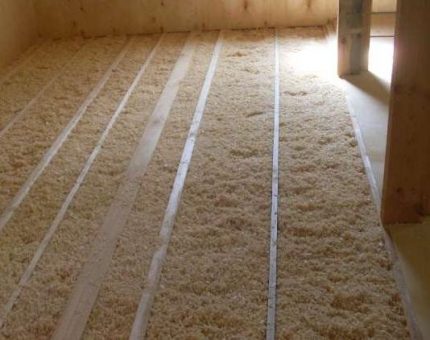
Thermal insulation with expanded clay
An inexpensive type of insulation is expanded clay, the work with which also has its own characteristics. In this case, sand is additionally laid. This material is neatly and evenly applied to the substrate, and then carefully tamped.
As a waterproofing, a liquid mastic is poured onto the sand layer, after which expanded clay is filled up, while it is necessary to monitor the maximum evenness of the coating. Next, a vapor barrier is installed on top of which the finish is laid.
Expanded clay is a rather heavy material, so it is not recommended to use it when warming buildings on a frame foundation.

Special techniques when working with foam
Penoplex is a common type of insulation. When using it, precise adjustment of the plates is required, which creates a barrier to the penetration of cold air. Sheets are laid between the lags, and for maximum traction they are attached with mounting glue to the floor and to each other.
Easy insulation foam considered the best option for thermal protection of the floor in a frame house. It provides a minimum load on the foundation, which avoids shrinkage of the structure.
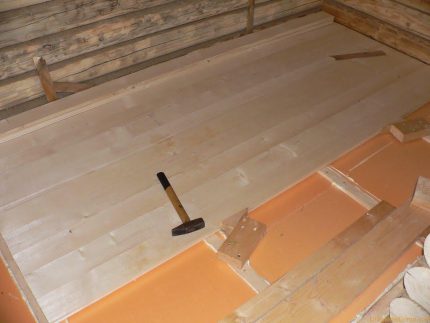
Conclusions and useful video on the topic
The video below demonstrates the process of warming a house along logs using mineral wool:
A video review that details the modern types of heat insulators:
In order to qualitatively perform the thermal insulation of the floor, it is important to carefully select the material, taking into account its features and the specific structure of the structure. Equally important is the observance of the installation technology recommended for this type of insulation, as well as the accurate implementation of all stages of work.
Have experience with floor insulation in a wooden house? Please tell readers what thermal insulation material you used, whether you were satisfied with the result. Comment on the publication and participate in discussions - the feedback block is located below.

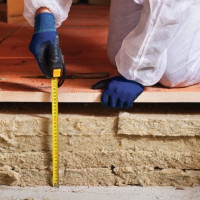 Warming of a wooden floor: popular insulation technologies + expert advice
Warming of a wooden floor: popular insulation technologies + expert advice 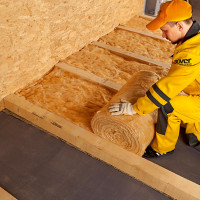 Insulation for the floor in a wooden house: materials for thermal insulation + advice on choosing insulation
Insulation for the floor in a wooden house: materials for thermal insulation + advice on choosing insulation 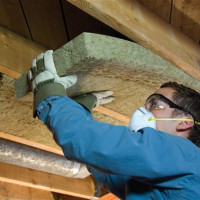 Insulation of the ceiling in a private wooden house inside and out: choosing the best material and the nuances of installation
Insulation of the ceiling in a private wooden house inside and out: choosing the best material and the nuances of installation 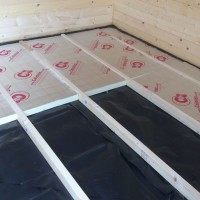 Garage floor insulation: varieties of insulation for the floor + step-by-step instructions
Garage floor insulation: varieties of insulation for the floor + step-by-step instructions 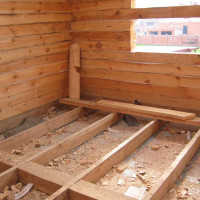 Floor insulation by logs: materials for thermal insulation + insulation schemes
Floor insulation by logs: materials for thermal insulation + insulation schemes 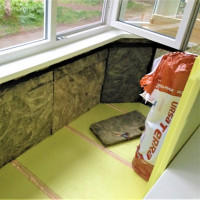 Do-it-yourself warming the balcony: popular options and technologies for warming the balcony from the inside
Do-it-yourself warming the balcony: popular options and technologies for warming the balcony from the inside  How much does it cost to connect gas to a private house: the price of organizing gas supply
How much does it cost to connect gas to a private house: the price of organizing gas supply  The best washing machines with dryer: model rating and customer tips
The best washing machines with dryer: model rating and customer tips  What is the color temperature of light and the nuances of choosing the temperature of the lamps to suit your needs
What is the color temperature of light and the nuances of choosing the temperature of the lamps to suit your needs  Replacement of a geyser in an apartment: replacement paperwork + basic norms and requirements
Replacement of a geyser in an apartment: replacement paperwork + basic norms and requirements
From his wife’s parents, he inherited a plot with a dilapidated house. It was decided to demolish it and build a new one. Now I’m building a house out of timber, the foundation has been leveled, the beams have been laid, the turn of the floors has come.
Actually, I consider it as the main options with mineral wool and extruded polystyrene foam. Floor beams 200 mm high. While leaning towards expanded polystyrene for reasons of simpler installation and the lack of the need to tinker with film and wind protection. After all, I understand correctly that for EPPS all this is not necessary? Because I tried to figure out these wilds, but even the masters themselves in each topic argue over a hundred pages and can’t decide how best and how to.
Good afternoon, Cyril. There are really many disputes. Associated with established technology over the years of practice.
EPPS, unlike most insulation materials, the same mineral wool has zero water absorption. If exactly exactly 0.2% by volume. It is because of this that there is all contention. They consider the properties of the material separately from the floor work system as a whole, and this is fundamentally not true.
I can assume: the floor is on the ground, then, according to technology, the underground should be ventilated. Accordingly, wind protection is necessary. At a minimum, it will play the role of protecting wooden beams.
Arrangement of products in the foundation for wooden floors is necessary, otherwise the floor will simply rot quickly enough.
Regarding vapor barrier, it will also not be superfluous. Wood flooring is quite mobile in itself, plus a technological gap remains between the floor and the wall.
EPPS wins before the mineral wool in many ways: lower heat transfer coefficient, zero water absorption, lack of “caking” of the material.
Without seeing your project, it is definitely difficult to answer.